ATI's New High End and Mid Range: Radeon X1950 XTX & X1900 XT 256MB
by Derek Wilson on August 23, 2006 9:52 AM EST- Posted in
- GPUs
A Matter of Memory: Revisiting the Mid-Range
When 512MB cards first came along (with the GeForce 7800 GTX 512), we ran some performance tests to try and ascertain the real world performance difference between these cards and ones with 256MB of RAM. We came up empty handed at the time. Today we are able to show that memory sizes above 256MB are actually starting to matter. With ATI's launch of the new X1900 XT 256MB, we have a direct comparison between two cards which are almost identical aside from the amount of memory on board. To be completely fair, X1900 XT 256MB cards built by ATI will also have full HDCP support, keys and all, but the major difference remains RAM.
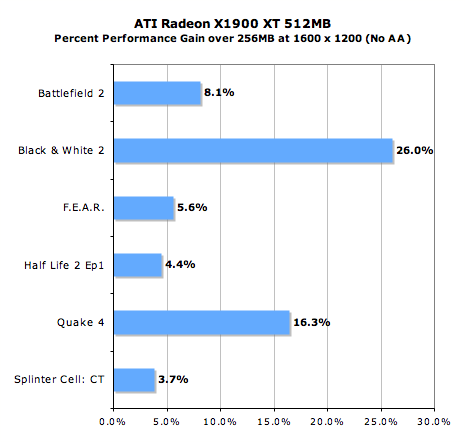
ATI dropped down to eight 8Mx32 as opposed to the eight 16Mx32 GDDR3 modules used on the original X1900 XT. Memory speed, bandwidth, and even layout can remain the same between cards, with only a slight difference in timings due to the different capabilities of each chip type. The result is that the X1900 XT 256MB is a slower solution than the X1900 XT that still offers exceptional performance for a terrific price.
The graphs below compare the new $279 X1900 XT 256MB to the rest of the sub-$300 cards we included in last week's mid-range GPU roundup. Note that the X1900 XT's chief competitor is NVIDIA's GeForce 7900 GT, which itself can be found for around $270. However, for as little as $20 more you can get a factory overclocked 7900 GT such as the eVGA GeForce 7900 GT KO SC clocked at 580/790 that all of the sudden becomes far more competitive. Because of the prevelance of factory overclocked (and warrantied) 7900 GTs, we've included the eVGA card as a reference of what you can get for the same price.
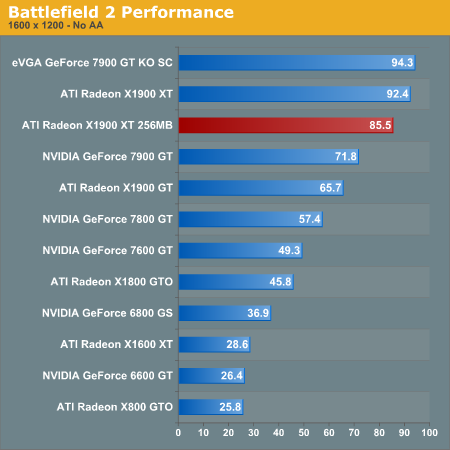
The 256MB drop in memory size doesn't impact BF2 enough to drop performance below the 7900 GT. The overclocked EVGA card does out perform even the 512MB X1900 XT in this test, but the 256MB version doesn't loose much value here as 85 fps is still way more than playable.
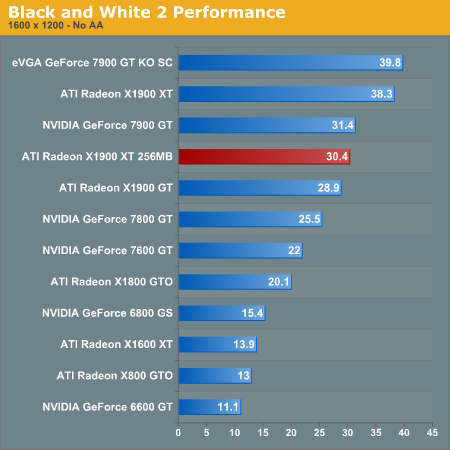
The 256MB X1900 XT falls in performance to just below the level of the stock 7900 GT. The competition is still tight, and we are about on par for the money here.
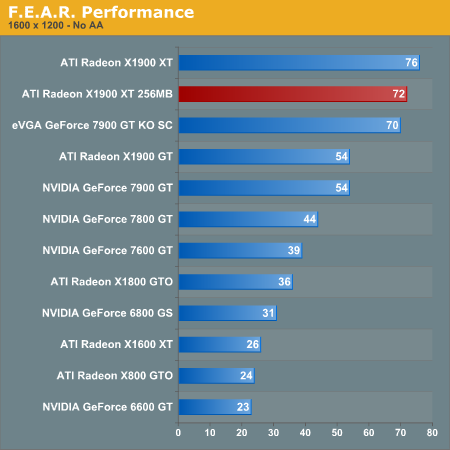
If F.E.A.R. performance is important to you, the X1900 XT 256MB is a better value than even the overclocked 7900 GT. The 512MB card still retains a small 5.5% lead over the 256MB card. This is one of the smaller performance drops we will see.
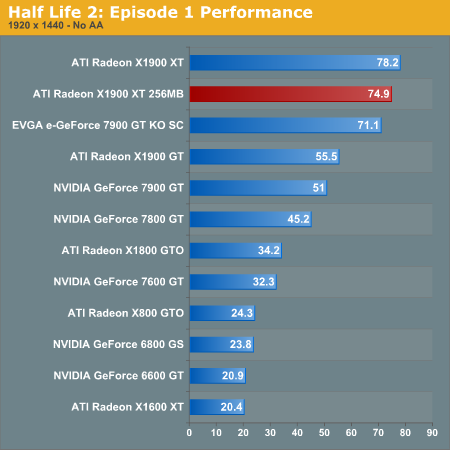
Under HL2:Ep1, performance drops a very small amount, but both X1900 XT cards are in strong competition with the overclocked 7900 GT.
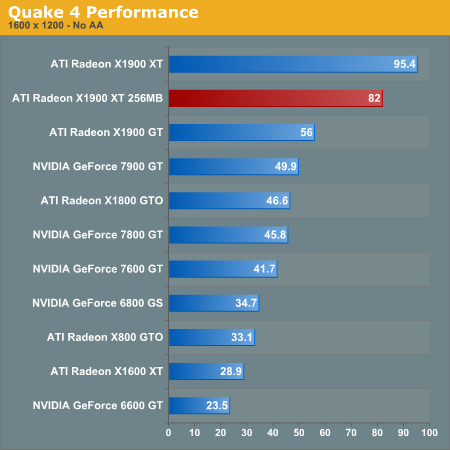
Quake 4 does give the 512MB card a bit of an advantage at 1600 x 1200, but the performance of the 256MB X1900 XT is still quite respectable given its target price of $279. The stock GeForce 7900 GT isn't in the same league as the X1900 XT.
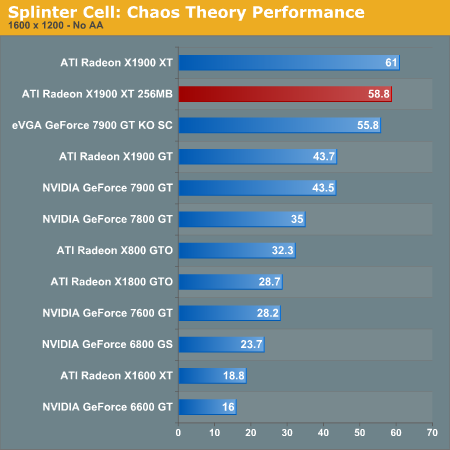
Spinter Cell rounds out our tests as one of those games where the larger frame buffer on the older X1900 XT does not do much. You lose less than 4% of your performance when going to the cheaper 256MB X1900 XT, which is a trade off we can live with. The regular GeForce 7900 GT can't hope to keep up with the 256MB X1900 XT, but if you get one of the factory overclocked cards such like the eVGA GeForce 7900 GT KO SC (more acronyms please) then you'll actually have performance competitive to the X1900 XT 256MB.
If the X1900 XT 256MB actually debuts at the ATI suggested price of $280, there won't be much of a reason to recommend anything but ATI parts from $220 up until we reach the highest end parts at above $400 where the lines start to blur again. While performance can fall very short of the X1900 XT 512MB at times, the X1900 XT 256MB remains competitive with our overclocked 7900 GT in every case but Black & White 2. The reduced memory version of the X1900 XT is just what ATI needed to pull out in order to fight back against the incredible overclockability of the 7900 GT.










74 Comments
View All Comments
JarredWalton - Thursday, August 24, 2006 - link
Anisotropic filtering was enabled in all tests at 8xAF as far as I know. When we use antialiasing, we generally enable anisotropic filtering as well.LoneWolf15 - Thursday, August 24, 2006 - link
Looks like there's no HDCP support or HDMI connector added like I'd expect with a brand new top-end card. And, they didn't add the new quieter cooler to the X1900XT. Pity. I doubt it would cost ATI more, and it'd up the sale of cards since people hate the noisy fan ATI has been currently using.I'll pass. My older (by alpha-geek standards) X800XL does the job fine.
P.S. -1 for not doing any bench tests with Elder Scrolls: Oblivion.
DerekWilson - Saturday, August 26, 2006 - link
also, all of these cards have HDCP support -- which I believe I mentioned somewhere in there. HDMI is up to the vendor.JarredWalton - Thursday, August 24, 2006 - link
+2 You might want to read page 8.LoneWolf15 - Thursday, August 24, 2006 - link
I don't know what's going on, I must have been blind. My apologies there, Jarred.Dfere - Thursday, August 24, 2006 - link
You just can't always eat your cake and then have it left over.YOu should change your phrase from "Sometimes we can have our cake and eat it too"
to "Sometimes we can eat our cake and have it too"
poohbear - Thursday, August 24, 2006 - link
the established exnglish expression is "you cant have your cake and eat it too", even if it doesnt make logical sense. There are many words and expressions that dont make sense in english (driveway, football, highway). Im guessing you're not a native english speaker, but that's the way the language is. now, please post about technology and not the logic of english expressions.Griswold - Thursday, August 24, 2006 - link
Whats wrong with football? Or do you mean american "football"?poohbear - Thursday, August 24, 2006 - link
can anyone confirm if those power consumption tests are for the entire system or just the vid cards? the highest figure was 267wts: a high end system that consumes 267wts underload is sweet! can you confirm that is indeed for the entire system (cpu, mobo, hdd, vid card... everything). thanks.JarredWalton - Thursday, August 24, 2006 - link
I'm pretty sure that this is power use for the entire system, but Derek's results are quite a bit lower than what I got on the ABS system I tested last week for X1900 CrossFire. Of course, the water cooling and extra fans on the ABS system might add a decent amount of power draw, and I don't know how "loaded" the systems are in this test. I would guess that Derek ran Splinter Cell: Chaos Theory for load conditions.